Equine Podiatrist- Cat Redwood
River 5 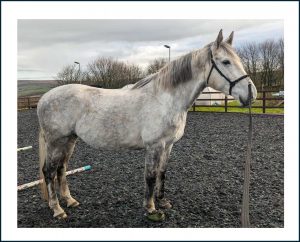 year old Irish Sports Horse
year old Irish Sports Horse
In October 2023 River presented with lameness on her right fore when being schooled and a strong pulse was detected in her right fore. It had previously been noted by River’s Equine Podiatrist (EP) that she had a small medial gap in her white line on the right fore so it was thought that this had allowed an abscess to develop by allowing foreign bodies to track into the hoof. Within 6 days an abscess burst out of the coronary band and within a further 10 days River appeared to be returning to soundness. Sadly the lameness returned and a vet was asked to check the hoof. Pus evidencing a recurrent abscess was observed, this time exiting via the heel bulb.
Despite the abscess site appearing to heal, River was not returning to full soundness so in November 2023 radiographs were taken of her hoof to look for underlying causes. None were identified so the cause of the lameness continued to be treated as a result of the initial abscess.
After a few months of on/off lameness in May 2024 the decision was made to send River for a full lameness workup in an Equine Veterinary hospital. Following radiographs and a CT scan it was discovered that she had osteitis (inflammation and infection) in the medial side of her right fore pedal bone and a loose fragment of bone. The vets made the decision to carry out surgery to remove the fragment of bone and infected material. During the initial surgery a window was created in the medial side of her hoof wall and a portion of her sole was removed.
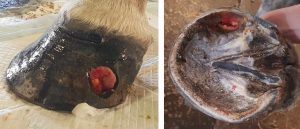
Surgical sites Post-initial surgery as seen on July 2024
Unfortunately, River’s hoof did not appear to be healing correctly following the initial surgery so her EP asked for her to be reassessed by the surgeon. In September 2024 River had further hoof surgery to remove further infected material and a larger piece of medial hoof wall was removed.
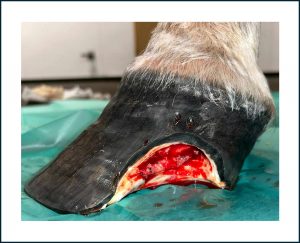 Surgical site post-second surgery September 2024
Surgical site post-second surgery September 2024
After a short period of box rest River slowly returned to turnout by the end of November 2024. She had a short period of lameness in February 2024 that was considered to be sole sensitivity due to lack of stimulation during the recovery period. In March 2024 she returned to ground work and by June 2024 River had returned to light ridden work. Her hoof still showed slight sensitivity on stoney surfaces but continued to improve.
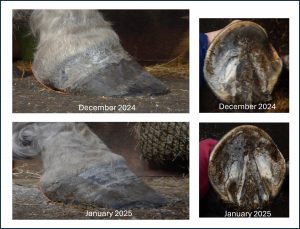 Loss of structure and remodelling: Due to the constant application of iodine to River’s hoof during the healing process and a lack of stimulation to the frog and digital cushion these soft tissue structures hardened, a deep central sulcus developed in the frog and the whole hoof “ran forward” leading to an underrun heels/ long-toe morphology.
Loss of structure and remodelling: Due to the constant application of iodine to River’s hoof during the healing process and a lack of stimulation to the frog and digital cushion these soft tissue structures hardened, a deep central sulcus developed in the frog and the whole hoof “ran forward” leading to an underrun heels/ long-toe morphology.
This figure illustrates how quickly the hoof began to remodel into a more healthy hoof morphology once the dressings were removed and the soft tissues of the hoof began receiving more stimulation.
Rivers hoof was managed with bandages and dressings as prescribed by the veterinary team and hoof boots and pads throughout the recovery process. Her hooves were trimmed on a 4-weekly cycle. An adaptive approach to trimming was required in order to manage the surgical site and the morphological changes to the hoof
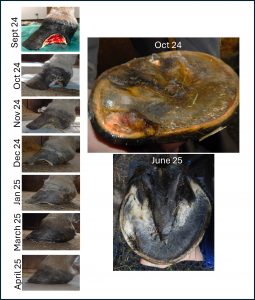 Surgical site recovery
Surgical site recovery
Quote from the owner: “The support I have had from my Equine Podiatrist during this process has been second to none. She has worked alongside my vets and continually advocated for the welfare of my horse, and supported me in requesting a re-referal when she thought something wasn’t right. Her training has enabled her to be flexible in her trimming approach and adapt to a rapidly changing foot. Her support has made this stressful process significantly easier and we will always be grateful for her amazing work.”
River has now returned to hacking and has started to build up her schooling work again.